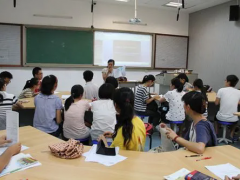介词的用法总结
1.总结介词的用法
介词用法大全 (早、午、晚要用in,at黎明、午夜、点与分。
年、月、年月、季节、周,阳光、灯、影、衣、冒in。 将来时态in。
以后,小处at大处in。 有形with无形by,语言、单位、材料in。
特征、方面与方式,心情成语惯用in。 介词at和to表方向,攻击、位置、恶、善分。
日子、日期、年月日,星期加上早、午、晚, 收音、农场、值日on,关于、基础、靠、著论。 着、罢、出售、偷、公、假,故意、支付、相反,准。
特定时日和“一……就”,on后常接动名词。 年、月、日加早、午、晚,of之前on代in。
步行、驴、马、玩笑on,cab,carriage则用in。 at山脚、门口、在当前,速、温、日落、价、核心。
工具、和、同随with,具有、独立、就、原因。 就……来说宾译主,对、有、方状、表细分。
海、陆、空、车、偶、被by,单数、人类know to man。 this、that、tomorrow,yesterday,next、last、one。
接年、月、季、星期、周,介词省略已习惯。 over、under正上下,above、below则不然, 若与数量词连用,混合使用亦无关。
‘ beyond超出、无、不能,against靠着,对与反。 besides,except分内外,among之内along沿。
同类比较except,加for异类记心间。 原状because of,、owing to、due to表语形容词 under后接修、建中,of、from物、化分。
before、after表一点, ago、later表一段。 before能接完成时,ago过去极有限。
since以来during间,since时态多变换。 与之相比beside,除了last but one。
复不定for、找、价、原,对、给、段、去、为、作、赞。 快到、对、向towards,工、学、军、城、北、上、南。
but for否定用虚拟,复合介词待后言。 ing型由于鉴,除了除外与包合。
之后、关于、在。
方面,有关介词须记全。 in内to外表位置,山、水、国界to在前。
如大体掌握如上介调用法口诀,就不易出错。当然,至于介词的详尽用法,同形词又是连词及副词等内容此章不讲。
下面对该口诀分别举例帮助你理解消化。 早、午、晚要用in 例:in the morning 在早上 in the afternoon 在下午 in the evening 在晚上 in the day 在白天 at黎明、午、夜、点与分 例: at dawn, at daybreak 在黎明时候 at noon 在中午 at night 在夜间 at midnight 在午夜 以上短语都不用冠词 at six o'clock 在6点钟 at 7:30 (seven thirty) 在7点半 at half past eleven 在11点半 at nine fifteen 在9点15分 at ten thirty a.m. 在上午10点30分 也可以写成 seven to five 5点差7分(半小时以上) five minutes after two 2点过5分 at a quarter to two 1点45分 at the weekend 在周末 年、月、年月、季节、周 即在“来年”,在“某月”,在“某年某月” (但在某年某月某日则用on),在四季,在第几周等都要用in。
例;in 1986 在1986年 in 1927 在1927年 in April 在四月 in March 在三月 in December 1986 1986年12月 in July l983 1983年7月 in spring 在春季 in summer 在夏季 in autumn 在秋季 in winter 在冬季 in the fist week of this semester 这学期的第一周 in the third week 在第三周 阳光、灯、影、衣、冒 in, 即在阳光下,在灯下,在树阴下,穿衣、着装、冒雨等都要用in。 例:Don't read in dim light. 切勿在暗淡的灯光下看书。
They are reviewing their lessons in the bright light. 他们在明亮的灯光下复习功课。 They are sitting in the shade of a tree. 他们坐在树阴下乘凉。
a prisoner in irons 带着镣铐的囚犯 He went in the rain to meet me at the station. 他冒雨到车站去接我。 The poor dressed (clothed) in rags in old society. 旧社会穷人们衣衫褴褛. 以及:in the bright sunlight 在明亮的阳光下 a merchant in disguise 乔装的商人 the woman in white (black, red, yellow) 穿着白(黑、红、黄)色衣服的妇女 in uniform 穿着制服 in mourning 穿着丧服 in brown shoes 穿着棕色鞋 in his shirt sleeves 穿着衬衫 将来时态in。
以后 例: They will come back in 10 days. 他们将10天以后回来。 I'll come round in a day or two. 我一两天就回来。
We'll be back in no time. 我们一会儿就回来。 Come and see me in two days' time. 两天后来看我。
(从现在开始) after。 (从过去开始) 小处at大处in 例:Li and I arrived at Heishan county safe and sound, all is well. Don't worry. 李和我平安地到达黑山县,一切很好,勿念。
I live in a great city (big city), my sister lives at a small town while my parents live at a village. 我住在大城市,我姐姐住在一个小城镇,而我的父母则住在农村。 I'm in Liaoning, at Anshan. 我住在辽宁省鞍山市. 有形with无形by,语言 、单位、材料in 例:The workers are paving a road with stone. 工人们正用石子铺路。
(有形) The teacher is correcting the paper with a new pen. 这位教师正用一支新笔批改论文。(有形) "Taking Tiger Mountain by Strategy" is a good opera. < <智取威虎山 > >是—出好戏。
(无形) The product is separated by distilation into gasoline and gas oil. 这种产品是用蒸馏分离出气油和粗柴油。 (表示方式、手段、方法——无形) I really can't express my idea in English freely in-deed. 我确实不能用英语流利地表达我的思想。
(。
2.英语介词的用法,怎么用(要详细)
⑴ 时间或地点介词in、on、at的用法区别:表示时间时, in表示在一段时间里(在将来时句子中则表示在一段时间之后), on表示在具体的某一天或者某天的上下午等, at表示在某个时刻或者瞬间;表示地点时, in表示在某个范围之内, on表示在某个平面上或与一个面相接触,at则表示在某个具体的场所或地点.如:He was born on the morning of May 10th.(他出生于五月十日的早晨)/ I usually get up at 7:00 in the morning.(我通常在早上的七点钟起床) / His glasses are right on his nose.(他的眼镜就架在他的鼻子上)/ He is at the cinema at the moment.(此刻他正在电影院)⑵ after与in表示时间的用法区别:“after+(具体时刻/从句)”表示“在…时刻之后”常用于一般时态;“in+(一段时间)”表示“在(多久) 之后”,常用于将来时态.如:He said that he would be here after 6:00.(他说他六点钟之后会来这儿)/ My father is coming back from England in about a month.(我父亲大约一个月以后从英国回来)⑶ since与for表示时间的用法区别:“since+(具体时刻/that-从句)”表示“自从…起一直到现在”,“for +(一段斶间)”表示“总共有…之久”,都常用于完成时态;如:Uncle Li has worked in this factory since 1970.(李叔叔自从1970年起就在这家工厂工作了)/ Uncle Li has worked in this factory for over 30 years. (李叔叔在这家工厂已经工作了30多年)⑷ by、in与with表示方式的用法区别:都可以表示“工具、手段”,但是by主要表示“乘坐”某个交通工具或“以……方式”,在被动句中可以表示动作的执行者;in表示“使用”某种语言/文字,with表示“使用”某个具体的工具、手段.如:We see with our eyes and walk with our feet.(我们用眼睛看东西,用双脚走路)/ Please write that article(文章) in English.(请你用英语写那篇文章)/ Let's go to the zoo by taxi.(我们打的去动物园吧.)/ It was written by Lao She.(那是老舍写的)⑸ about与on的用法区别:都可以表示“有关…”,但是about的意义比较广,而on主要表示“有关…(专题/课程)”.如:Tom is going to give a talk on the history of America.(汤姆要作一个美国历史的报告)/ They are very excited talking about the coming field trip.(他们兴致勃勃地谈论着即将来到的野外旅游)⑹ through与across、over的用法区别: through指“穿过…(门洞/人群/树林)”; across和over可以指“跨越…(街道/河流)”,可互换,但是表示“翻过…”时只能用over. 如:Just then a rat (鼠)ran across the road.(就在那时一只老鼠跑过路面)/ There is a bridge across/over the river.(河上有座桥)/ They climbed over the mountain and arrived there ahead of time.(他们翻过大山提前到达了那里)/ The visitors went through a big gate into another park.(参观者们穿过一个大门来到另一个公园)(7)as与like的区别:两个词都表示“像……”,但是as译为“作为……”,表示的是职业、职务、作用等事实,而like译为“像……一样”,表示外表,不是事实.如:Let me speak to you as a father.(我以父亲的身份和你讲话.)(说话者是听者的父亲) / Let me speak to you like a father.(让我像一位父亲一样和你讲话)(说话者不是听者的父亲)(8)at the end of、by the end of、to the end、in the end的用法区别:at the end of…既可以表示时间也可以表示地点,译为“在…末;在…尽头”,常与过去时连用;by the end of…只能表示时间,译为“在…前;到…为止”,常用于过去完成时; in the end与at last基本等义,表示“终于、最后”,通常用于过去时;to the end译为“到…的终点为止”,前面往往有表示运动或连续性的动词.如:By the end of last term we had learned 16 units of Book III.(到上学期期末我们已经学习了第三册16个单元)/ At the end of the road you can find a big white house with brown windows.(在路的尽头你能找到一幢有棕色窗户的白房子)/ They left for Beijing at the end of last week.(上周末他们动身去了北京)/ In the end he succeeded in the final exams.(他最终在期末考试中考及格了)/ We should go on with the work to the end.(我们应该把工作干到底)/ Follow this road to the end and you will see a post office.(沿这条路走到底就能看见一家邮电局)(9)for a moment、for the moment、in a moment、at the moment的区别:for a moment“一会儿、片刻”(=for a while),常与持续性动词连用;for the moment“暂时、目前”,常用于现在时;in a moment“一会儿、立即、马上”(=soon; in a few minutes),一般用于将来时;at the moment“此刻,眼下”(=now),用于现在进行时.如:Please wait for a moment.(请稍等)/ Let's leave things as they are for the moment.(暂时就维持现状吧!) / I'll come back in a moment.(我过会儿回来)/ I am very busy at the moment.(眼下我很忙)(10)but的问题:用介词but引出另一个动词时,要注意:如果前面有do,后面就用原形动词,前面没有do时,后面的动。
3.谁能帮我归纳一下汉语介词的用法
1、介词起标记作用,依附在实词或短语前面,共同构成“介词短语”.2、介词短语整体主要修饰、补充谓词性词语,充当状语、定语、补语,有时用作句首修饰语,标明跟动作、性状有关的时间、处所、方式、原因、目的、施事、受事、对象等.3、在现代汉语中,因总是依附在前面,所以介词又叫前置词.介词常用在名词性词语前面.有的介词还可以放在谓词性词语前做标记,如“小黑因迟到受罚.索罗斯以精明著称.大火由吸烟引起.”均表原因.4、介词后面的成分叫介词宾语,与动词宾语性质不同,由于介词是虚词,介宾之间的组合是粘着的附加关系.5、介词的语法特征:不能单独作句法成分,总要构成介词短语作状语,少数还可以构成介词短语作补语、定语.6、汉语的介词绝大多数是动词虚化而来的.有些词至今还是动介兼类词.7、古代汉语介词宾语同现代汉语一样通常放在介词的后边,但是少数介词,主要是“以”的宾语因为表达的需要而放在介词的前边.现代汉语中介词的宾语是不能省略的,古代汉语中“以、为、与、从”等介词的宾语有时可以省略,“于”的宾语不能.在语法功能上,古代汉语由“因、为、与、从”等组成的介词结构一般作状语,与现代汉语相同,但“于”字介宾结构除了表示对于、关于的意义要作状语以外,其余(如表处所、时间)则多作补语;而“以”字在介宾结构中表工具,方式的既可作状语,也可作补语.这些方面,现代汉语一般是用状语来表达.此外,现代汉语 的介宾结构还可以作定语(与群众的联系),古代汉语则不能.。
4.初中英语里所有介词的用法
The best I can do.同时推荐你一个网站:/?fromuid=193856 介词(preposition):也叫前置词。
在英语里,它的搭配能力最强。但不能单独做句子成分需和名词或代词(或相当于名词的其他词类、短语及从句)构成介词短语,才能在句中充当成分。
介词的种类:(1)简单介词:about, across, after, against, among, around, at, before, behind, below, beside, but, by, down, during, for, from, in, of, on, over, near, round, since, to, under, up, with等等。(2)合成介词:inside, into, outside, throughout, upon, without, within (3)短语介词:according to, along with, apart from, because of, in front of, in spite of, instead of, owing to, up to, with reguard to (4)分词介词:considering, reguarding, including, concerning 介词短语:构成 例句 介词+名词 We go to school from Monday to Saturday. 介词+代词 Could you look for it instead of me? 介词+动名词 He insisted on staying home. 介词+连接代/副词 I was thinking of how we could get there. 介词+不定式/从句 He gives us some advice on how to finish it.介词的用法:一、介词to的常见用法 1.动词+to a)动词+ to adjust to适应, attend to处理;照料, agree to赞同, amount to加起来达…, belong to属于, come to达到, drink to为…干杯, get to到达, happen to发生在某人身上, hold to紧握, lead to通向, listen to听, occur to想起, object to反对, point to指向, respond to回答, refer to参考;指的是…;涉及, reply to回答, see to负责, stick to坚持, turn to求助, write to给某人写信。
b)动词(+sth.)+to+sb. announce to通知某人, describe to向某人描述, explain to向某人解释, express to对某人表达, mention to提及, nod to向某人点头, report to报告, say to告知, shout to对某人大叫, suggest to对某人提建议,speak to与某人交谈, talk to跟某人谈话, whisper to和某人低声耳语。 c)动词+sth./sb.+ to +sth./sb. add to增加, compare to比作, carry to运送至, devote to致力于,introduce to介绍给, invite to邀请参加, join to连接到, leave to委托给,reduce to下降至, sentence to判处, take to带到。
2. be +形容词/过去分词+ to be alive to觉察;晓得, be attentive to注意;留心, be awake to知晓, be blind to缺乏眼光, be close to紧挨着, be common to对某人来说很普通, be contrary to违反;反对, be devoted to致力, be deaf to不愿意听, be equal to有…的力量, be exposed to暴露;遭受, be fair to对…公平, be familiar to对某人来说熟悉, be grateful to对某人心存感激, be good to对…有好处, be harmful to对…有危害, be important to对…重要, be kind to友好对待, be known to周知于, be married to嫁给, be moved to转移到, be near to靠近, be necessary to对…有必要, be opposite to在对面, be opposed to反对, be pleasant to合某人之意, be proper to专属, be polite to礼貌待人, be rude to粗暴对待, be relative to与…有关, be strange to不习惯, be similar to类似, be suitable to适合, be true to忠实, be thankful to感激, be useful to对…有用, be used to习惯。 3.to+名词构成的词组 to a degree在某种程度上, to date到现在为止,to one's feet跳起来,to one's mind照…看来, to one's surprise使…吃惊,to one's taste符合胃口, to oneself独自享用, to order定做,to the letter不折不扣地, to the point中肯地 二、at的常见用法 at构成的词组比较多,要细心区分。
1.动词+ at arrive at抵达,call at访问某地, catch at(it)当场抓住, come at攻击, fire at向…开火,glance at瞟一眼, glare at怒目而视, grieve at忧伤,knock at敲,laugh at嘲笑, look at看一眼, pull at拉扯, rejoice at对…高兴,smile at向某人微笑, shoot at朝…射击, stare at怒目而视,thrust at刺向, tear at撕, tremble at颤抖,wonder at吃惊,work at工作。 2. be +形容词/过去分词+ at be angry at恼怒于, be alarmed at对…保持警觉,be astonished at对…吃惊, be bad at不擅长, be clever at对某事很灵巧,be delighted at高兴,be disgusted at厌恶, be disappointed at对…失望,be good at擅长, be impatient at对…不够耐心, be mad at狂热于,be pleased at对…感到高兴, be present at出席, be satisfied at满意,be surprised at吃惊, be shocked at对…非常震惊,be terrified at受到…的恐吓,be quick at对…很机敏。
3.at+名词构成的词组 at a distance在一定距离,at a loss不知所措, at a time一次,at all一点也不,at any cost不惜一切代价,at best最好也只是,at first起初,at hand手头,at heart在内心里,at home在家;无拘束,at last最后,at least至少,at most最多,at once马上,at present目前。 三、介词on的常见用法 on的用法比较重要,本文介绍它的一些常见用法: 1.动词+on a)动词+ on要认真区分下面一些词组 act on对…有作用, bring on促使;导致, call on拜访某人,count on依赖, carry on执行,depend on取决, 。
5.英语短语中介词用法归纳一下
英语中所有的介词和介词短语1) at once 立刻 2) at last 最后3) at first 起先,首先4) at the age of… 在……岁时 5) at the end of… 在……之末6) at the beginning of… 在……之初 7) at the foot of… 在……脚下 8) at the same time 同时9) at night / noon 在夜里 / 中午10) with one's help 在某人的帮助下,由于某人的帮助11) with the help of … 在……的帮助下 12) with a smile 面带笑容 13) with one's own eyes 亲眼看见 14) after a while 过了一会儿 15) from now on 从现在起 16) from then on 从那时起 17) far example 例如 18) far away from 远离19) from morning till night 从早到晚 20) by and by 不久21) by air mail 寄航空邮件22) by bike / air / train / bus 骑自行车 / 乘飞机 / 火车 / 汽车23) by ordinary mail 寄平信 24) by the way 顺便说 25) by the window 在窗边26) by the end of… 到……底为止 27) little by little 逐渐地28) in all 总共 29) in fact 事实上30) in one's twenties 在某人二十几岁时 31) in a hurry 匆忙32) in the middle of 在……中间33) in no time (in a minute) 立刻,很快 34) in time (on time) 及时 35) in public 公众,公开地 36) in order to 为了…… 37) in front of 在……前面 38) in the sun 在阳光下 39) in the end 最后,终于 40) in surprise 惊奇地41) in turn 依次 42) of course 当然 43) a bit (of) 有一点儿 44) a lot of 许多 45) a little 一点儿46) on one's way to 某人在去……的路上 47) on foot 步行,走路48) a talk on space 一个关于太空的报告 49) on the other hand 另一方面 50) at / on the weekend 在周末 51) on the left (right) 在左(右)边52) on the other side of 在……另一边 53) on the radio 通过收音机(无线电广播) 54) to one's joy 使……高兴的是55) to one's surprise 使……惊讶的是1. 表示时间的介词及介词短语إ in,at,on,before,after,till,since,for,from,to,until, by,in the middle of,at the beginning of, at the end of,at half past five,at night,in a week,in the morning,in class,at sunrise, in spring / summer / autumn / winter,on Sunday,on Saturday afternoon,on a winter evening,for a long time,for two months,after school,since liberation,before lunch,at the time of,at the age of。
2.表示地点的介词及介词短语إin,at,into,to,on,beside,before,behind,above,under,outside,inside,up,from,far,from,near,across, off, down, among, past,between,out of,around,in the front of, in the middle of, at the back of,at the foot of,at home,at the gate,at the table,in the sky。
6.【如何快速记忆介词的用法
of与for的用法以及区别 for 表原因、目的 of 表从属关系 介词of的用法 (1)所有关系 this is a picture of a classroom (2)部分关系 a piece of paper a cup of tea a glass of water a bottle of milk what kind of football,american of soccer? (3)描写关系 a man of thirty 三十岁的人 a man of shanghai 上海人 (4)承受动作 the exploitation of man by man.人对人的剥削。
(5)同位关系 it was a cold spring morning in the city of london in england. (6)关于,对于 what do you think of chinese food?你觉得中国食品怎么样? 介词 for 的用法小结 1. 表示“当作、作为”。如: i like some bread and milk for breakfast. 我喜欢把面包和牛奶作为早餐。
what will we have for supper? 我们晚餐吃什么? 2. 表示理由或原因,意为“因为、由于”。如: thank you for helping me with my english. 谢谢你帮我学习英语。
thank you for your last letter. 谢谢你上次的来信。 thank you for teaching us so well. 感谢你如此尽心地教我们。
3. 表示动作的对象或接受者,意为“给……”、“对…… (而言)”。 如: let me pick it up for you. 让我为你捡起来。
watching tv too much is bad for your health. 看电视太多有害于你的健康。 4. 表示时间、距离,意为“计、达”。
如: i usually do the running for an hour in the morning. 我早晨通常跑步一小时。 we will stay there for two days. 我们将在那里逗留两天。
5. 表示去向、目的,意为“向、往、取、买”等。 如: let's go for a walk. 我们出去散步吧。
i came here for my schoolbag.我来这儿取书包。 i paid twenty yuan for the dictionary. 我花了20元买这本词典。
6. 表示所属关系或用途,意为“为、适于……的”。如: it's time for school. 到上学的时间了。
here is a letter for you. 这儿有你的一封信。 7. 表示“支持、赞成”。
如: are you for this plan or against it? 你是支持还是反对这个计划? 8. 用于一些固定搭配中。如: who are you waiting for? 你在等谁? for example, mr green is a kind teacher. 比如,格林先生是一位心地善良的老师。
答题不易、满意请给个好评、你的认可是我最大的动力、祝你学习愉快、>_。
7.介词用法大全
1、年月日--月日年 2003年2月1日 February 1st 2003. 2、日期中有几号的,前面用介词“on”,其余用“in” in the spring of 1987 in 1999 in May on May 5th 3、在具体某一天用介词on on 用于日、周日或某日中的一段时间: on July 2 7月2日 on Sunday 在星期天 on the morning of last Sunday 上星期天早晨 in 一日中的早、下午、晚,周、季、年、世纪例如: in the afternoon 在下午 in a week 一周 in summer 在夏天 at 点钟;一日中的黎明、中午、黄昏、半夜; at six(dawn)6点钟(在黎明)如果时间词前面有next,this,last every等修饰语时,常不用介词。
介词用法知多少 介词是英语中最活跃的词类之一。同一个汉语词汇在英语中可译成不同的英语介词。
例如汉语中的“用”可译成:(1)用英语(in English);(2)用小刀(with a knife);(3)用手工(by hand);(4)用墨水(in ink)等。所以,千万不要以为记住介词的一两种意思就掌握了这个介词的用法,其实介词的用法非常广泛,搭配能力很强,越是常用的介词,其含义越多。
下面就简单介绍几组近义介词的用法及其搭配方法。 一. in, to, on和off在方位名词前的区别 1. in表示A地在B地范围之内。
如: Taiwan is in the southeast of China. 2. to表示A地在B地范围之外,即二者之间有距离间隔。如: Japan lies to the east of China. 3. on表示A地与B地接壤、毗邻。
如: North Korea is on the east of China. 4. off表示“离……一些距离或离……不远的海上”。如: They arrived at a house off the main road. New Zealand lies off the eastern coast of Australia. 二. at, in, on, by和through在表示时间上的区别 1. at指时间表示: (1)时间的一点、时刻等。
如: They came home at sunrise (at noon, at midnight, at ten o'clock, at daybreak, at dawn). (2)较短暂的一段时间。可指某个节日或被认为是一年中标志大事的日子。
如: He went home at Christmas (at New Year, at the Spring Festival, at night). 2. in指时间表示: (1)在某个较长的时间(如世纪、朝代、年、月、季节以及泛指的上午、下午或傍晚等)内。如: in 2004, in March, in spring, in the morning, in the evening, etc (2)在一段时间之后。
一般情况下,用于将来时,谓语动词为瞬间动词,意为“在……以后”。如: He will arrive in two hours. 谓语动词为延续性动词时,in意为“在……以内”。
如: These products will be produced in a month. 注意:after用于将来时间也指一段时间之后,但其后的时间是“一点”,而不是“一段”。如: He will arrive after two o'clock. 3. on指时间表示: (1)具体的时日和一个特定的时间,如某日、某节日、星期几等。
如: On Christmas Day(On May 4th), there will be a celebration. (2)在某个特定的早晨、下午或晚上。如: He arrived at 10 o'clock on the night of the 5th. (3)准时,按时。
如: If the train should be on time, I should reach home before dark. 4. by指时间表示: (1)不迟于,在(某时)前。如: He will come by six o'clock. Jack had made some friends by the time you came. (2)在……间,在……的时候。
如: He worked by day and slept by night. 5. through指时间意为“从……开始到结束”,此时与throughout相同。如: We work hard all through the year. 三. near, by, beside, at表示“在……附近”时的区别 1. near表示相对的近,实际距离可能还很远。
如: Suzhou is near Shanghai. 2. by和beside都表示靠近,实际距离不可能很远,但beside比by更具体地表示出“在……旁边”的意思。如: He was sitting beside her. 3. at也有“在旁边”的意思,但多表示有目的的行为所处的位置,而by和beside仅表示位置关系。
如: The students are sitting at the desks listening to the teacher. Several students are sitting by / beside the window talking about a film. 四. at, in和on表示地点时的区别 1. at表示地点: (1)用于指较小的地方。如: I shall wait for you at the station. (2)用于门牌号码前。
如: He lives at 115 Zhongshan Road. 2. in表示地点: (1)用于指较大的地方。如: He lives in Shanghai. (2)虽然是很小的地方,如果说话人住在那里,也可用in。
商店、学校、机关等,若看作一个地点(point)用at,若看作一个场所(place)用in。如: I met him at the post-office. I'm now working in the post-office. 3. on表示地点,一般指与面或线接触,意为“在……上;在……旁”。
如: The picture was hanging on the wall. New York is on the Hudson River. 五. besides, except, except for, but表示“除……外”之间的区别 1. besides表示“除了……以外,还有……”,具有附加性质。如: Besides Mr Wang, we also went to see the film.(王先生也去了) 注意:besides用于否定句中时,与except, but同义,可互换。
如: We have no other books besides / except these. 2. except表示“……除外”,具有排它性质。如: We all went to see the film except Mr Wang.(王先生没去) 3. except for表示“除了……”,即表示除去整体中的一部分。
如: The composition is very good except for a few spelling 。







